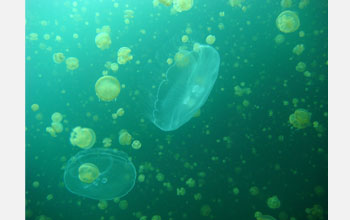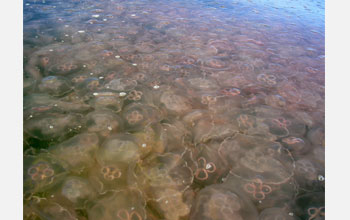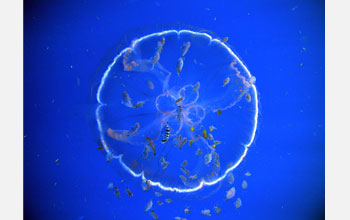All Images
News Release 08-216
New Online Report on Massive Jellyfish Swarms Released
This material is available primarily for archival purposes. Telephone numbers or other contact information may be out of date; please see current contact information at media contacts.

Millions of jellyfish gather in a marine lake in Palau in the Pacific. Scientists believe that some jellyfish swarms are natural phenomena and that some jellyfish swarms are promoted by human activities.
Credit: Michael Dawson, University of California, Merced
Download the high-resolution JPG version of the image. (1 MB)
Use your mouse to right-click (Mac users may need to Ctrl-click) the link above and choose the option that will save the file or target to your computer.

In the Gulf of Mexico's densest swarms, there are more jellyfish than there is water.
Credit: Monty Graham, Dauphin Island Sea Lab
Download the high-resolution JPG version of the image. (945 KB)
Use your mouse to right-click (Mac users may need to Ctrl-click) the link above and choose the option that will save the file or target to your computer.

Swimming and swarming in the world's oceans for more than 500 million years, gelatinous animals have influenced marine ecosystems almost as long as marine ecosystems have existed.
Credit: NOAA
Download the high-resolution JPG version of the image. (361 KB)
Use your mouse to right-click (Mac users may need to Ctrl-click) the link above and choose the option that will save the file or target to your computer.
A researcher swims with a jellyfish species known as Chrysaora on the coast of Argentina. (The researcher's wet suite protects him from the jellyfish's sting.) To learn about jellyfish research, visit the National Science Foundation's Special Report on jellyfish; Jellyfish Gone Wild: Environmental Change and Jellyfish Swarms.
Credit: John H. Costello of Providence College
A lion's mane jellyfish in Narragansett Bay. Notice that many smaller jellies are captured in this jellyfish's tangle of tentacles. During the summer of 2008, the lion's mane jellyfish, which has a very painful sting, swarmed along the east coast of the U.S. The largest lion's manes live in the Arctic and may have tentacles that are up to 100 feet long. That's longer than a 100-foot-long blue whale.
Credit: John H. Costello of Providence College


